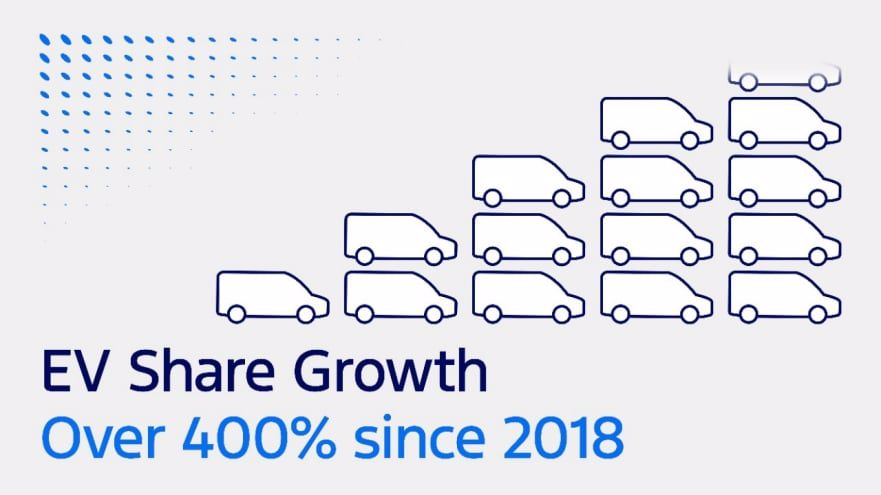Explorer - 261 Promotion


DUNTON, UK, May 30, 2024 – The recognition of electrification’s business value by small and medium enterprises (SMEs) has the potential to accelerate EV adoption and significantly benefit business productivity and the European economy. However, charging remains a concern.
These are the key findings from a report commissioned by Ford Pro: The Economics of Commercial Van Usage Across Europe 2024, published by the Centre for Economics and Business Research (Cebr). 1
The report estimates that van-related businesses contributed around €1 trillion across the EU and UK in 2023 – an increase of 6.5 per cent since 2021 and 27.4 per cent since 2017. On this basis, if van-powered businesses were an EU member state, they would be the sixth largest by GDP. In the EU, an estimated €14.1 billion (1.6 per cent) of that activity was supported by electric vans.
Ford Pro – the #1 CV brand in Europe 2 – commissioned the report to better understand the broader European commercial van landscape, comprised of 23 million SMEs, including owner operators, which account for 99 per cent of businesses in Europe. 3
Initially, commercial electric vehicle adoption was believed to be led by larger businesses with fleet managers and corporate sustainability goals. Now, SMEs are increasingly adopting EVs as they recognise the significant business benefits. A survey of more than 1,000 commercial van drivers found that these businesses are already realising significant energy cost savings as well as improving their productivity and operations with supporting technology. Even non-EV adopters are looking at switching within 5 years, although charging remains a concern.
“We have been helping small businesses to build the economies of Europe for almost 60 years – but the greatest opportunity to improve their uptime and productivity lies ahead,” said Hans Schep, general manager, Ford Pro, Europe. “Florists, plumbers, and bakers will play a leading role in taking EV adoption to the next level, and we will bring large fleet levels of charging, software and servicing support to these small businesses so they can electrify in the way that best makes sense for them.”
Ford Pro solutions help operators decide when and how to electrify and maximise the benefits to their business. Ford Pro’s offering includes a comprehensive line-up of EV and plug-in hybrid vans supported by productivity solutions such as vehicle and fleet management software, charging solutions, servicing and all-in-one financing. Last week, Ford Pro announced an integrated home charging solution designed for business needs.
The Economics of Commercial Van Usage Across Europe 2024 revisits a dramatically changed landscape since a previous report was published in 2019, showing that despite the impact of the pandemic, the cost-of-living crisis and war in the Ukraine, the impact of vans on the economy has increased dramatically.
The report includes an update to the Electrification Index, a measure of commercial EV adoption status and future potential for five prominent European van markets: France, Germany, Italy, Spain and the UK. Considering factors including electric van sales, charging points, incentives and the increase in low emissions zones, the Index identifies that adoption and potential increased in most markets since the last calculation in 2018.
This increase is partly supported by significant growth in electric van availability. For example, Ford Pro has now produced or announced electrified versions of every model in its Transit family. The E-Transit – 4 Ford Pro’s first electric van in Europe – outsold its nearest competitor by more than five to one in 2023 to lead its segment with over 50 per cent market share. 2
The Cebr study found that Germany had the highest EV proportion of new van registrations in 2023 at 9.5 per cent. The UK showed the greatest growth in electric van sales since the last report in 2018, with share increasing from 0.3 per cent to 6 per cent. France is identified as the market with most electrification potential, just as it was in the 2018 report, reflecting its already strong adoption of electric vehicles and high-quality charging infrastructure. Overall, Spain showed the most improvement in its Electrification Index score.
Survey respondents said reduced operating costs were the top reason to switch to EVs (46.3 per cent) supported by annual EV van charging costs of €3,700 vs €12,400 for a petrol or diesel van. Analysis of the total cost of operating electric vans compared to diesel or petrol equivalents found electric vehicles can make up for their higher initial purchase costs within a typical three-year ownership timeframe.
Beyond financial benefits, the survey also found why SMEs are turning to EVs. Access to low emissions zones was the joint most common reason to switch (46.3 per cent), followed by concern for the environment (45 percent) and brand reputation (45 percent).
Charging time was the biggest concern for those who have not yet switched to EVs (38.1 per cent) with upfront purchase costs also an issue (37.7 per cent). Despite this, amongst those yet to switch, a majority (58.6 per cent) said that they were at least somewhat likely to choose an electric van over the next five years.
Operators who have already switched to EVs are more likely to recognise the importance of technologies and services that complement van ownership. Amongst business adopters of technologies and software, the overwhelming majority reported positive productivity impacts. This was particularly the case for those adopting vehicle safety and security measures, fleet management solutions, and communication software.
Similarly, an overwhelming majority of business software adopters reported positive operational impacts. This was particularly likely among adopters of compliance and reporting systems, telematics integrated with other systems, and communication software.
“The transition to electric could bring considerable societal benefits on both local and global scales, primarily through the mitigation of harmful pollutants and greenhouse gas emissions,” said Nina Skero, Chief Executive of Cebr. “Our analysis also demonstrates that vans already support a significant proportion of economic activity across European markets. Indeed, van-reliant industries contributed €860 billion to European Union economies last year. The portion of this figure attributed to electric vans is expected to grow as adoption continues and more businesses realise and accrue EV operational savings.”
1 May 2024 report by the Centre for Economics and Business Research estimating the economic activity in van-dependent industries across five national markets, plus the EU. Commissioned by H+K Strategies and Ford Motor Company.
2 2023 full year figures from S&P Global, formerly IHS Markit Insight. Austria, Belgium, Britain, Czech Republic, Denmark, Finland, France, Germany, Greece, Hungary, Ireland, Italy, Netherlands, Norway, Poland, Portugal, Spain, Romania, Sweden, Switzerland.
3 European Commission
4 Up to 402 km driving range based on full charge of E-Transit with extended range option. Estimated range using Worldwide Harmonised Light Vehicle Test Procedure (WLTP). Figures shown are for comparability purposes and should only be compared with other vehicles tested to the same technical procedures. Actual range varies due to factors such as temperature, driving behaviour, route profile, vehicle maintenance, lithium-ion battery age and condition.